FARMS: APHIDOS
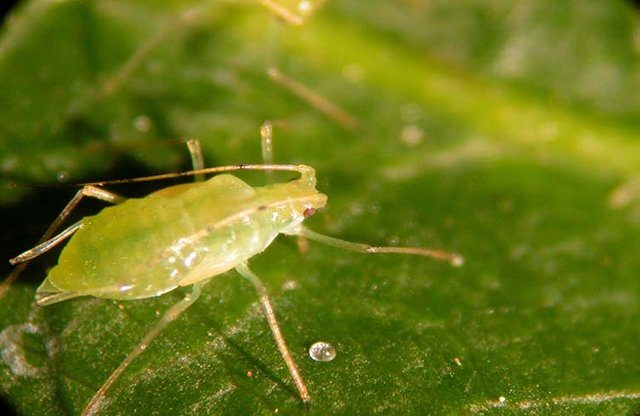
Common name: green aphid, yellow aphid of cereals, aphid of the spike.
Scientific name: Schizaphis graminum, Rhopalosiphum maidis, Metopolophium dirhodum, Sitobium avenae
How are aphids identified?
They are organisms of small size, varied colors mainly green, yellow or black. Generally smooth, although sometimes they can have spots. The body is soft of ovoidal shape, without evident distinction between the different regions (head, thorax and abdomen). They can be wingless or winged.
What are the damages of aphids on crops?
Aphids have great ecological and agronomic importance because they compromise the value of crops and ornamental plants. This pest causes direct and indirect damages that are translated later in diminution of yield.
The direct damage is caused by sucking the phloem from the plants by introducing a stylet that allows it to pierce the epidermal tissue of the stem of the plants. They also incorporate toxic saliva and extract large amounts of sap, which causes chlorosis, spots and leaf death.
Some species are very specific, and feed on a single species of plant or crop (monophagus), while others feed on a large number of species (polyphagous).
The second type of damage is indirect and is observed when the pests present in the culture are transmitters of viruses. The populations of aphids are influenced by a complex of climatic variables. The precipitations diminish the populations of some species of aphids while years with dry climate increase them, making necessary in many cases the application of control measures.
There are also indirect effects of aphids on plants as a consequence of feeding. On the one hand, the aphids excrete the excess sugar as a molasses, which when deposited on the leaves favors the development of molds of soot, soot or bold (Cladosporium sp.), Reducing the photosynthetic activity of the plant. Additionally, when this fungus stains the fruits, it depreciates its commercial value. On the other hand, they can transmit to the plant a great variety of toxic substances and / or be vectors of phytopathogenic viruses.
"Schizaphis graminum" Rondani - green aphid of cereals affects corn, barley and wheat and is the most widespread aphid species.
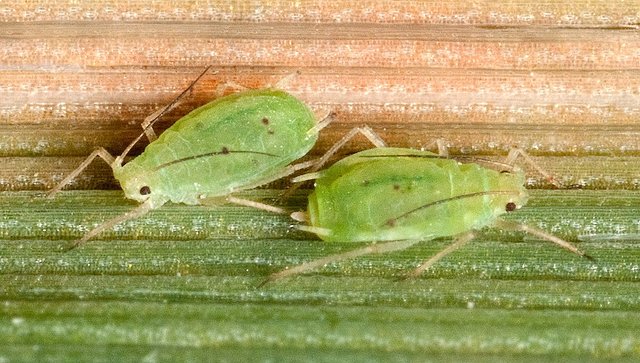
This species attacks the wheat from its source to encañazón and is generally located on the underside of the leaves and is favored by temperatures below 20 ºC and dry weather, and is not affected by frost.
As for its attacks are autumnal affect the crops in the early stages, from the seedling to encañazón. It causes damage whose severity depends on the degree of development of the crops and the population density of the pest. In early attacks, wheat seedlings can be completely destroyed.
When the crop is more developed the losses caused by this species are variable (between 25 to 60%) depending on the climatic conditions and the state of the crop. In addition, S. graminum is vector of yellow barley dwarf virus (VEAC)
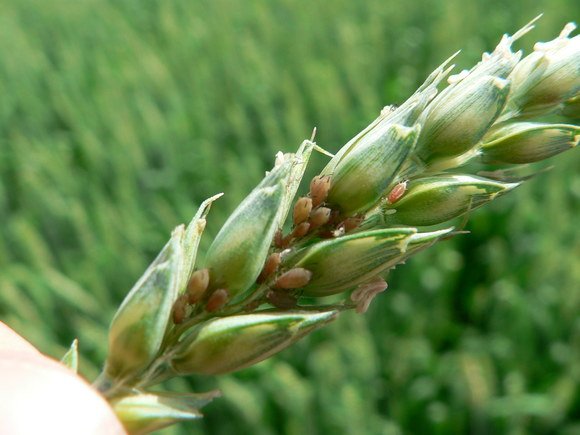
Rhopalosiphum maidis - aphid of the corn has been identified with habits similar to this species (aphid of the oat or of the stem). This insect is one of the vectors of the viruses that cause the yellow dwarfism of the barley and the mosaic dwarf of the corn Diuraphis noxia it can be a vector of numerous viruses, such as the barley yellow dwarf virus, the striped mosaic of barley and the mosaic of sugarcane.
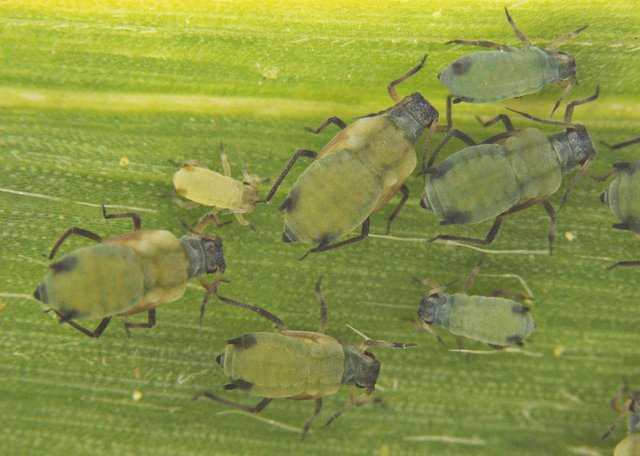
Types of aphids that attack cereals: wheat, oats, barley and corn.
Green aphid of cereals (Schizaphis graminum)
Attacks the wheat from its source until encaiazón forms colonies and is located on the underside of the leaves. The greatest damage is observed during the two weeks after the emergence of the seedlings. The attack in the crop is characterized, at first, by the presence of yellow patches. Aphids are favored by temperatures below 20º C and dry weather, not affected by frost. They appear from emergency to maturation.
Yellow aphid of cereals (Metopolophium dirhodum)
It attacks the wheat from the end of tillering to the spigot, forming colonies on the underside of the lower leaves. As the attacked leaves dry they are transferred to the upper leaves, including the flag leaf. Damage by suction of the sap causing yellowing of the leaves and reduction of the height of the plants. It can transmit the yellow dwarf virus of cereals.
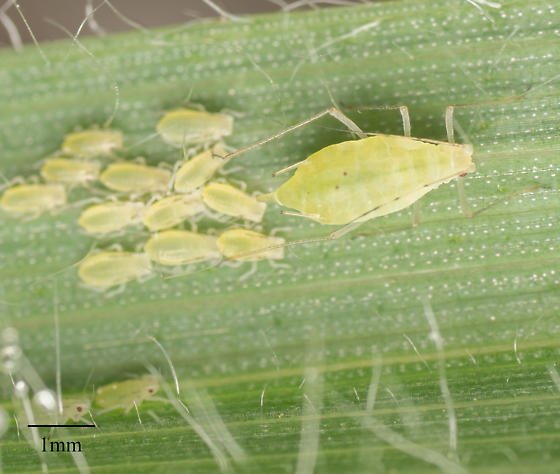
Aphid of the spike (Sitobium avenae)
It is generally located on the rachis of the spikes, causing yield reductions by reducing the size of the grain. The moment of greatest damage goes from flowering to the milky state of the grain, producing a negative effect on the size of the grains. It can transmit yellow dwarf virus.
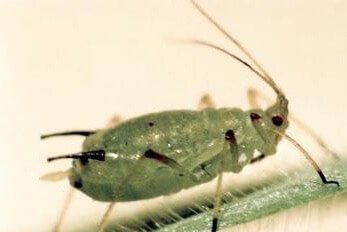
Russian aphid (Diuraphis noxia)
It can attack the wheat during the whole cycle. The colonies are located in the upper part of the plants mainly from the end of tillering to the pre-harvest. The damage potential of this aphid is greater in dry times. The extraction of sap causes a longitudinal winding in the leaves and the injection of toxins with the saliva produce a striated of purple color with low temperatures or striated white with temperate temperatures. Infestations of this species in the state of a flag leaf cause the production of vain or malformed spikes and, in extreme cases, prevent its emergence. In state of pasty grain the Russian afid does not produce damage.
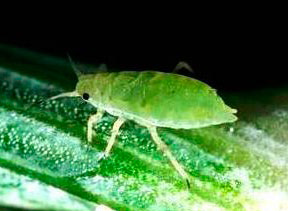
Aging of oats (Rhopalosiphum padi)
It usually has low populations, so its importance lies mainly as a virus transmitter. The colonies of this species are located in the aerial parts of the plants or at ground level and can be observed in winter and spring.
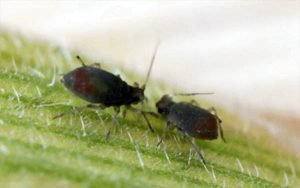
Aphid of corn (Rhopalosiphum maidis)
It can be observed in any phenological stage of the corn, being located inside the leaves that are emerging. Description: the body size is 1.5 to 2.7 mm., Bluish green and sometimes black. Short antennas that, like the legs, are dark. Siphons smaller than half the distance between their bases and dark as the cauda. The base area of the siphons is dark purple.
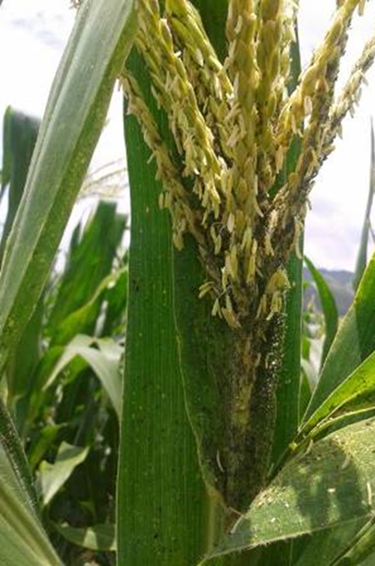
Aphid of the root of cereals (Rhopalosiphum rufiabdominalis)
It has the peculiarity of forming underground colonies by feeding on the roots or on the neck of the plants. It is located in the neck of the plant and root zone. The information of this species is scarce and no insecticides are registered for its control.
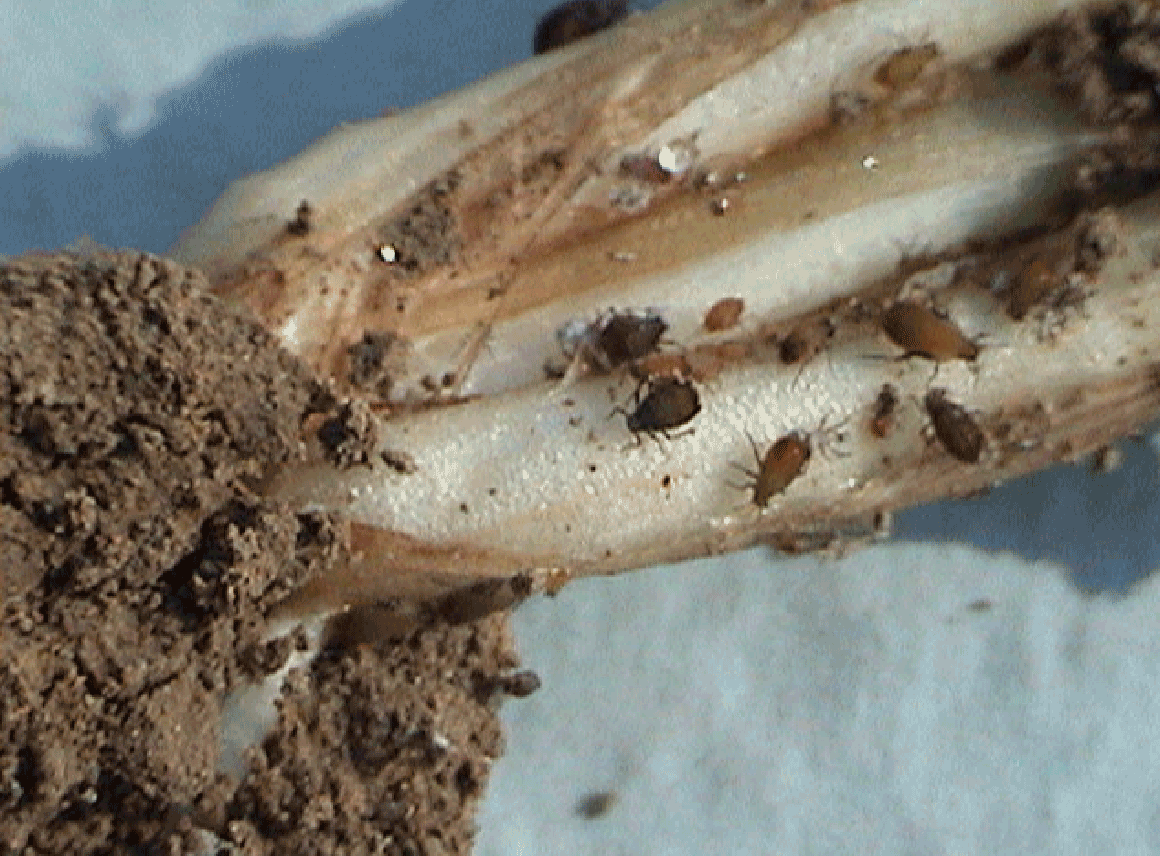
Black aphid of cereals (Sipha maydis)
It is usually found in the upper part of the basal leaves, in the insertion of the same with the stem. When the populations are high, they can also be found on the underside of the leaves and until colonies are detected in a flag leaf. The direct damages it causes have not yet been quantified because it is a species of recent discovery in the crop. This species is transmitting the virus of "barley dwarfism".
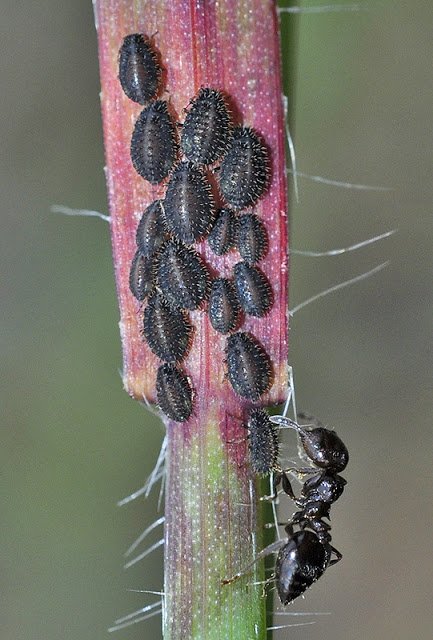
What are the alternatives for the control and management of this pest?
It is desirable to make an integrated management of the pest, combining different preventive and control measures.
For this, preventive practices should be applied, such as the elimination of weeds and proper management of irrigation and drainage of the soil so that the roots have an adequate habitat; as well as avoiding often unnecessary practices such as drastic pruning in the case of shrub and tree species that weaken the plants.
In the case of chemical control, the decision criterion must consider the specific economic threshold of each species and the phenological state of the crop.
In addition, the presence of natural enemies must be carefully observed. Aphids have numerous natural enemies among which we find predators, parasitoids and fungi, which exert strong pressure to keep populations below the damage thresholds.

For more information visit:
https://www.engormix.com/agricultura/articulos/afidos-pulgones-temibles-enemigos-t39563.htm#
If you got here ... Infinite thanks for reading me.
"God bless you and protect you"

Beautifully crafted publication, thanks for enlighten us
Resteem
(to be a part of this community; ensure to always use #farms and #steemchurch for agricultural related post)
SteemChurch Farm ( @FARMS)
upvote for me please? https://steemit.com/news/@bible.com/2sysip